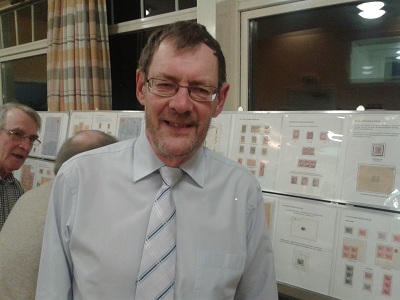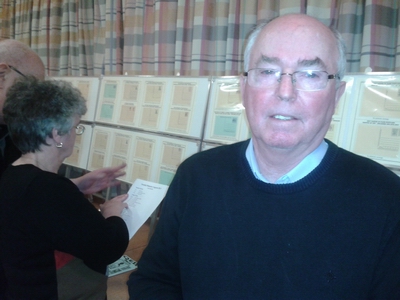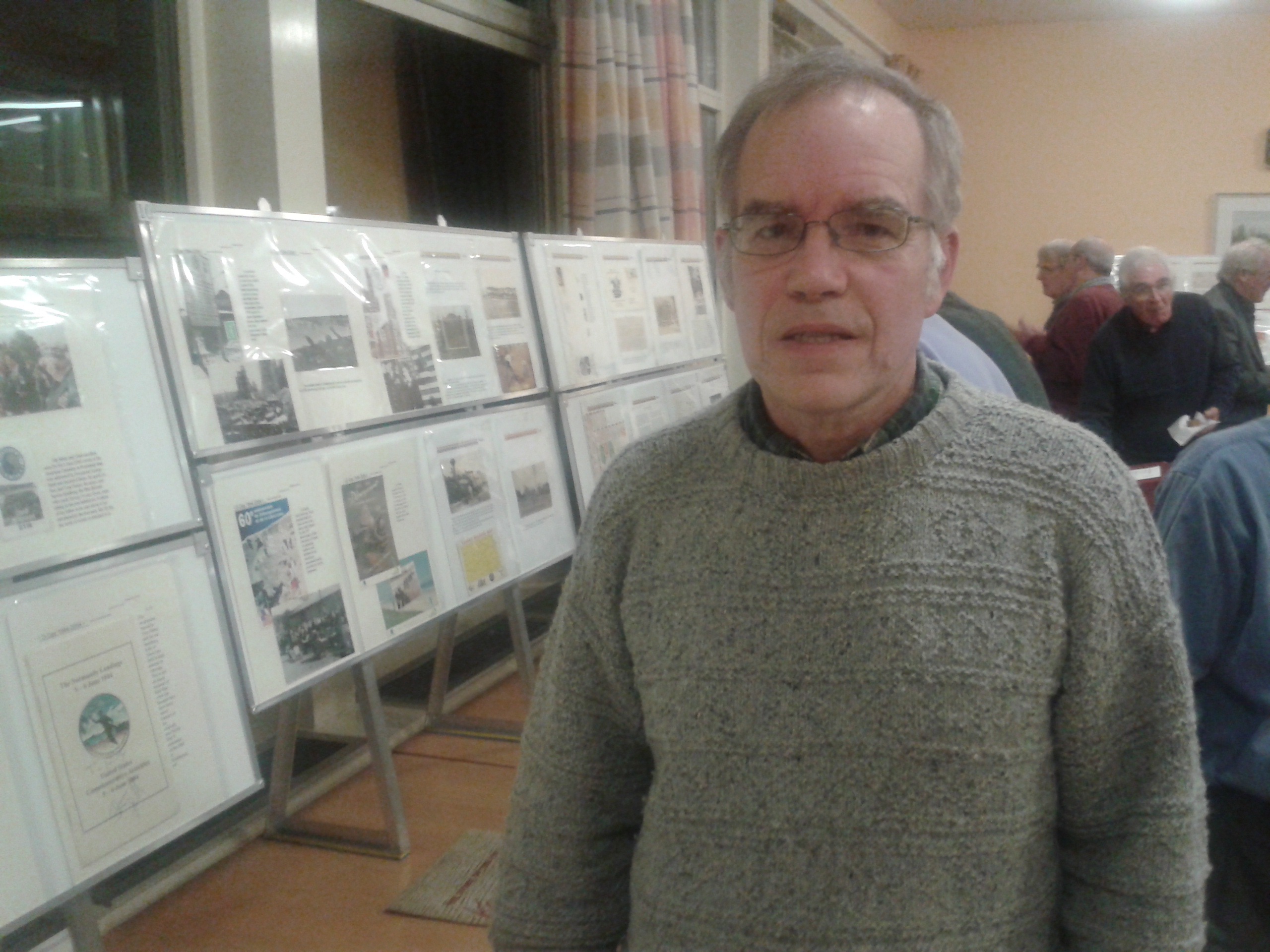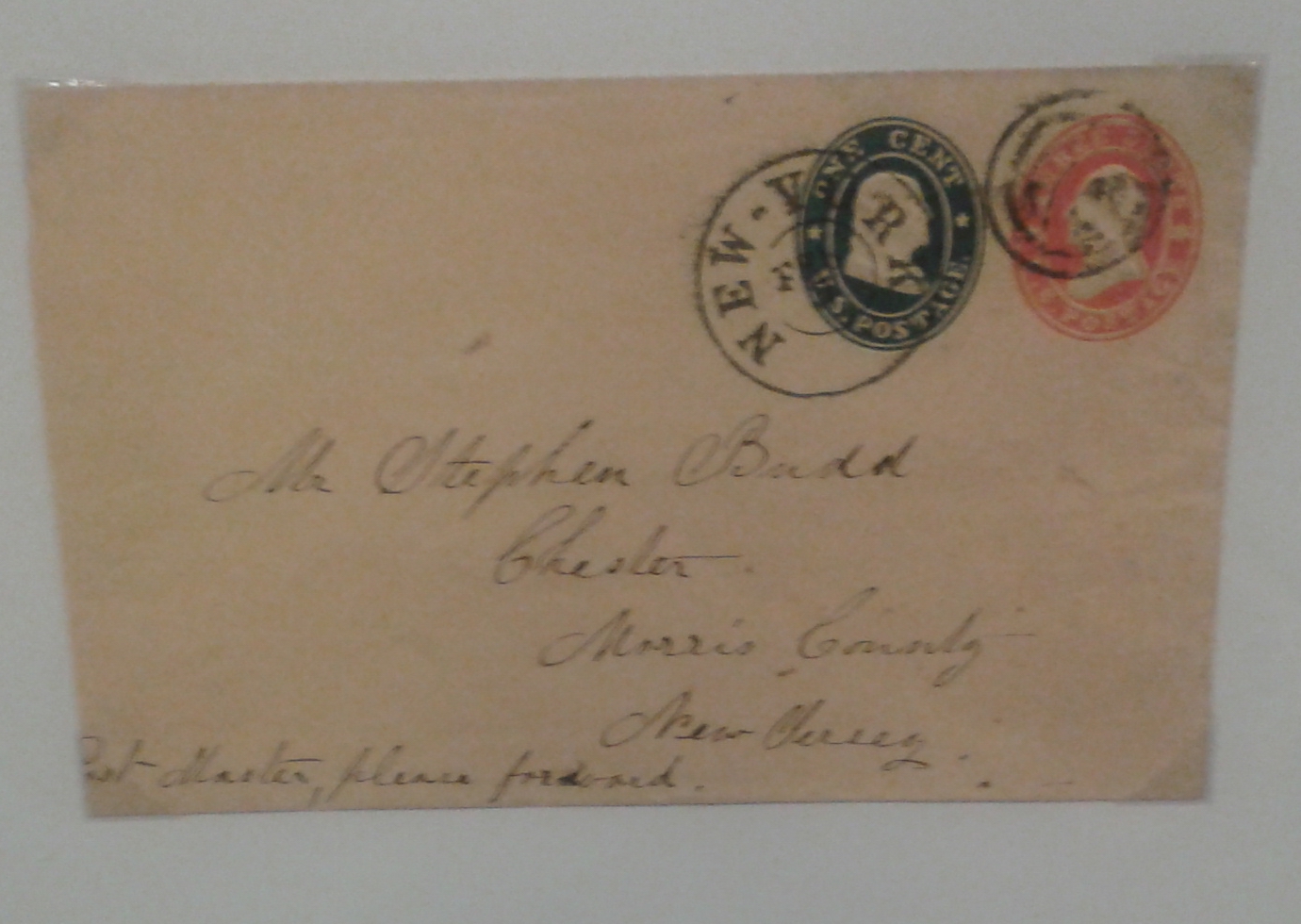
![]()
Aberdeen Philatelic Society: 2011 - 2012 News Archive
Visit from Perth Society - 29th March 2012
Our meeting of 29th March comprised two very different exhibits by our visitors from Perth Society. For the first half we were entertained by Robbie McLeish who showed the very attractive birds issue from Ireland from the first printings in 1997 to the final ones in 2005.
Robbie explained that this was a complex issue. This he amply demonstrated with stamps produced by 4 printers located in England, Ireland, the Netherlands and Australia. There were self adhesive and normally gummed issues. There were phosphor and non phosphor issues. There were issues in punts and pence, and in euros and cents, as well as issues during the transition where values were given in both currencies.
In addition there were special limited edition exhibition sheets and special booklets as well as one case where an incorrect spelling had been used, that was later corrected. But overall, it was the excellent designs that made these stamps so attractive!
Following the break Stewart Templeton introduced his display of 1935 George V Silver Jubilee issues. These included many varieties including the Canadian "weeping princess" now Queen Elizabeth, and these were mainly on cover. In some cases Stewart was able to show complete sheets including the positional varieties. He also showed a variety of memorabilia from the jubilee including a commemorative tin, postal order and cigarette cards.
Stewart continued with Indian Jubilee issues used in Tibet, Aden, Nepal and Burma and examples of the "support the jubilee fund " cachet used in India. There were also some fascinating and unusual rocket mail labels issued by Stephen H Smith for his experimental Rocketgram service over the river Roopnarain Kolaghat.
All in all another interesting and varied display for the society!
Tasmanian Revenues and Goats - 15th March 2012
Francis Kiddle, a past President of the Royal Philatelic Society and Honorary Fellow of the Royal, entertained the Society with his display on 15th March. These were two very different exhibits, the first half being Tasmanian Revenues and the second a thematic display of Goats.
To commence his display Francis explained that Tasmania had been the first Australian state to introduce revenues, when a tax on newspapers was introduced in 1827. Later, in 1863, additional taxation was needed owing to the withdrawal of subsidies from the UK. Francis showed examples of both types of revenue, and illustrated that because of the limited number of values available multiples were often needed to cover the required taxation. He explained how the rates were calculated and pointed out that badly printed stamps were often put to local revenue use, when they didn't look good enough for use as postage. After their withdrawal from use, reprints were issued in 1889, and Francis noted that these are relatively common in large multiples.
A more interesting design was demanded in 1887 and De La Rue became involved in the platypus design, for which Francis displayed a hand drawn sketch as well as key plate design and die proofs for high values. Both postal and tax use was demonstrated on a variety of documents.
For his second display, Francis gave a comprehensive exhibit of material on goats. Particularly interesting were his insights into thematic collecting, with a number of useful general tips for those who wish to display thematic material. Francis owns two pet goats acquired sixteen years ago and this sparked his interest in collecting. His view is that each sheet of the display should include at least three philatelic items, as his certainly did! The display included stamps, post cards, covers, and unusual items such as colour trials as well as other material that gave a comprehensive account of the theme.
Francis pointed out that thematics should tell a story as distinct from being just "goats on stamps". His display did that and educated all present on the subject. The first sheets gave a guide to show what to expect in the remainder of the display, and followed with sections entitled goat characteristics, goats in ancient time, today's goat, goat as the provider, goats in religion and mythology, and finally goats and their survival.
Francis's depth of knowledge was clear, and his display was an education to us all, with its most interesting and unusual and varied material.
Finland - 1st March 2012
Albert Megginson, a member of Harrogate Society, and a fellow of the Royal Philatelic Society, gave the society a display of Finland, on 1st March.
The varied display started with the Golden Ear charity postal stationery of 1935 to 1940, so called because of the ears of wheat shown in the imprinted stamps. These issues raised money for a women's convalescent homes charity. They were not popular and after their withdrawal the the remaindered cards were returned to the charity, after being invalidated by use of a triangle printed on the imprinted stamp.
Albert followed this with a display of railway related material, commencing with TPO's, both first and second class, and then railway postmarks, railway internal mail and railway station postmarks. He pointed out the potential confusion with the railway from Helsinki to St Petersburg, where different calendars meant that there were 12 days difference between the dates. He included railway souvenir postmarks, including marks from II, a town in North Finland, and examples of the fascinating themed postmarks, included the postmark for a train ferry opened on 13 March 1967, where a train was shown, on a ship.
An ex railway man himself, Albert's extensive knowledge of the Finnish rail system was very clear, but members must have been jealous of his stories, including his obtaining permission to travel on 2 Finnish TPO's - evidenced by the original, postmarked, permission document.
For the second half of his display Albert commenced with stamps designed by Signe Hammarsten Janssen. S. H. Janssen designed many stamps in the period 1929 - 1949 including wartime charity issues. The fine designs and production demonstrated why these are a favourite with Albert. He followed these with numerous Christmas labels, from the scarce early ones, and charity stamps including the long annual tuberculosis series from 1949 to 1961.
He followed this with some interesting examples of forgeries, then some military charity stamps, next some varied examples of tourist postmarks - including some camping ones depicting tents and caravans. Then auto bus postmarks - appropriately with buses shown on the postmark, and finally some Finnish paquebots, again appropriately, with ships depicted in the postmark.
All in all a very interesting display of very varied material!
Belgian Congo - 16th February 2012
Thanks to Ian Kennaway for the following report on the meeting of 16th February:
Our stand in President for the evening, Graham Searle, introduced Dr. Charles Lloyd, whose subject for the evening was ‘Belgian Congo’. Charles explained that because he had previously shown the Society the issues from 1887 to 1920 he would concentrate with the issues from the 1920’s and onwards.
However, to summarise earlier history, he started his presentation with a sheet of the first issue of stamps, that followed the Berlin Congress of 1885 at which the vast Congo basin was awarded to King Leopold II, who viewed this country as his private estate. This status was altered in 1908 when the Belgian Government took over and the country became a colony, resulting in ‘Congo Belge’ with issues being overprinted. In the 1920’s stamps were produced in the UK, USA and Belgium resulting in a range of styles. From the 1930’s all stamp production (a pictorial definitive and commemoratives) took place in Belgium. The German occupation of Belgium in 1940 cut off supplies, which resulted in issues being printed in South Africa and the UK. Stocks of earlier stamps were surcharged as an emergency measure and charitable surcharges appeared. Belgium, being a bilingual nation led to Waterlow taking care to print stamps in both French and Flemish to avoid offence.
During WWII, 12 editions of a Belgian cultural magazine, ‘Message Journal’, published by exiles in London were issued. Within which each was bound a special mini-sheet of a single Congo stamp. Subscribers alone had the option of purchasing one additional full set (at a premium). The stock of 300 remainders (of each mini-sheet) were reused in 1950 to honour the UPU with a printed border on reduced selvedge. The display continued illustrating commemorative definitives up to Independence in 1960. Following on from this was a selection of WWII censored mail. Railway parcel stamps and maritime mail were shown, then covers carried on early internal (LARA) services and pioneering international flights. It was pointed out that the first Belgium to the Congo flight took over 50 days to travel the journey, although the a flight time was only some 76hours.Therefore, the earliest external airmail was flown internally (in the Congo) then transported by ship to Dakar (Senegal) before being flown onward to Paris.
In the second half Charles started with covers carried on further pioneering flights. After that there were examples of letters that had travelled overland and later by plane to Rhodesia, or road, ferry & rail to the East African ports-of-call on the British Imperial Airways African route (for speedy onward carriage to Europe). SABENA, the Belgian national carrier started developing its colonial service in 1935 (3 years after Imperial). From 1937, a co-ordinated service was arranged between SABENA and a French carrier operating a service to Madagascar (which over flew the Congo) to improve the frequency of the airmail service to Europe. Examples of all of these were displayed.
In 1959 panic swept through the country after civil unrest, and independence was granted to an unprepared country soon after, in 1960. Along with the independence commemorative issue selected earlier Belgian Congo issues were overprinted ‘Congo’ and sold concurrently. These and the use of colonial stamps on cover up to 4 years after demonetisation (due to shortages) were shown.
Within weeks of independence, the State of Katanga broke away and initially used overprinted Congo stamps. There were many misprints, perhaps just for the philatelist. Next part of another state, South Kasai, also separated and overprinted colonial issues, which were also presented.
To quell the troubles and reunify the country, UN troops moved in and items of mail from Danish, Irish, Ethiopian and Indian contingents were shown. India sent a contingent large enough to justify a full field postal service and items handled by their field Post Offices are now much sought after, especially from Indian collectors. Later, in 1964, leaders of “The Simba Rebellion” (centred at Stanleyville) issued overprinted with Congolese and colonial stamps. Examples were shown. The display concluded with issues that honoured Dag Hammarskjold, the UN Secretary General (lost in a plane crash) and examples from the following, relatively more peaceful, times that followed reunification.
The meeting concluded with a vote of thanks, given by George Stephan, who praised Charles expertise for his subject and especially appreciated the Airmails.
India - 2nd February 2012
In the absence of the president, former president David Kindley, introduced Joe Ritchie's presentation, to our meeting on 2nd February.
Joe explained that there are 200,000 post offices in India and that 10 billion items, including 4 billion postcards, are posted each year. For many people without 'phone or internet the post remains the main method of communication. To encourage this communication the government has kept the price of sending postcards artificially low, since independence in 1949.
In the first half of his display Joe presented these post cards, beginning with the first issues and including reply paid cards. The first commemorative cards for Gandhi and for the 100th anniversary of the postage stamp in India were included, these examples being at the postcard rate of 5 pies. By 1968 that rate had increased to 10 pies and in 1973 India insisted on the PIN - Post Office identity Number - being included in the address, to ensure that mail reached the right office. Eventually competition post cards were introduced but for these the normal letter postage was charged resulting in an increasing disparity with the price charged for correspondence postcards. By 2003 the competition cards were 10 rupees compared to the postcards at 50 pies - a 20 times difference. From 1975 India started printing advertisements on the left side of the address side of the card to further subsidise them and although the number of different cards was limited to start with, the idea has caught on, and has resulted in a very large number of different cards being issued, in all of the 18 regional languages in India. Although there are a very large number of different cards issued, it's not expensive to collect them, as although the letter rate cards cost 10 rupees each - approximately 10p, the pictorial correspondence cards are at a reduced rate of 25 pies or about 1/4p each. As Joe said however, the problem is actually getting all of the cards issued, since many are only available locally.
For the second half of the display Joe had an entirely different display, this time including some stamps! This display was split into two parts comprising Jammu and Kashmir and Indian Ship mail. Jammu and Kashmir post office was open for only 26 years from 1866 to 1894, after which the Maharajah was deposed and Indian stamps were used. Joe showed examples starting from the earliest crude hand stamped circular issues of Jammu and Kashmir. He pointed out that these are in watercolour and therefore have a tendency to run or even wash out completely, in a humid climate. From 1878 the stamps were in oil colour and the stamps were replaced with rectangular ones from 1886. Joe had complete sheets of these to entertain us!
For the final part of the display, Joe presented British Ship Mail to India for the period 1803 to 1860. To start with all mail was via the East India Co ships from Tilbury as they had a monopoly of trade routes. However the monopoly was lost in 1819 and from then on various ports were used, each of which used different hand stamps, all amply illustrated in Joe's display.
In conclusion, this was a fascinating display of philatelic material, rarely to be seen in the UK.
Alphabet Night - 19th January 2012
Our meeting of 19th January was the Alphabet Night, which this season comprised material related to the letter "A". Organiser for the evening was Vice-President, Graham Searle, and a total of 27 members participated by displaying a wide variety of material, all somehow related to the letter "A". A vote was held to determine the displays believed by members to be the best, and prizes awarded to the winners.
The display voted the best was that provided by Peter Payne, on Canadian Admirals, and by coincidence this was also the first display presented. The second best display, shown part way through the second half, was a thematic display of Apiculture by Dougal Macintosh.
There were many other interesting displays demonstrating the wide variety of material of interest to our members. In the first half, these included exhibits on the themes of "A" overprints, Ancestors, Proverbs (beginning with A), Antarctica, Autographs, Continents beginning with A (i.e. all except Europe), Åland, British Packet Service to West Africa, Finland 1867 issues sent to A's, and Apollo Achievements.
The second half included exhibits on the themes of Afghanistan Adventures, Alphabet ABC & Queen Astrid, Aerogrammes and Authors, Aalborg Locals, Aarhus, Azad Hind, Attitudes, Aero-Tag Poland, Alphabetical order, Airmen on Active Service in Aden, Aberdeen pre-stamp covers, Anniversary of the Accession - a preview of forthcoming Diamond Jubilee, Archaeologists, and finally, not seen before Canadian Admirals. Thus the displays both commenced and concluded with the Admirals.
In his vote of thanks, the President, Mike Longhurst praised all members who had contributed to an enjoyable evening. It was just as well that no more members had contributed, as we should then have needed a third half to present the display!
President's Night - 5th January 2012
Mike Longhurst, the Society President, presented at our first meeting of the New Year. Mike started by advising that he "collects what he fancies", and the ensuing display confirmed this to be true! He stated that one of his aims was to display stamps not often displayed and there was indeed a wide variety of material on display. The only common theme was that Mike's display comprised stamps as distinct from covers, etc., and that he appears to have an affinity with back of the catalogue and overprinted stamps
The display started with New Zealand officials and overprints on New Zealand for Niue, Cook Islands, etc. Then a wonderful selection of advertisements on the back of New Zealand issues, followed by various revenues with stamps up to a face value of £1000, and Life Insurance stamps. next some marvellous engraved North Borneo issues and overprinted Labuan stamps.
Next came some Sudan officials, Ceylon service issues, overprints on GB, particularly Seahorses, for Ireland, also issues for Levant, Morocco Agencies, Nauru, former Italian Colonies, Cyprus and Southern Rhodesia. Followed by early Barbados and Mauritius Issues.
And that was just the first half! Mike then did what was described as a "Jack Waterman", i.e. the sheets in their protectors were turned over to reveal the second part of his display.
This started with French stamps overprinted for Memel, some with several overprints and surcharges. Mike followed with Burma peacock local overprints which we were told have been extensively forged - Mike didn't claim that all his were authentic. Next Mike showed Polish local overprints on Germania issues, again a difficult area with many forgeries, sometimes with the overprints having been applied to used German issues.
These was followed by French Colonial overprints, again Mike pointed out that many have been forged, but these, he stated, are easier to detect. And finally, Mike displayed machine testing labels, including the double width labels used to test the machines used to apply the GB 1957 Scout Jamboree issue to first day covers.
All in all a marvellous display which amply demonstrated the huge variety of stamps that are available for us to collect, albeit it would be very difficult to replicate the extent of this collection without very many years of collecting!
Room Auction - 15th December 2011
Our annual room auction was held at our meeting of 15th December 2011. This evening, the last meeting of 2011, saw the participation of a large contingent of members. The auctioneer encouraged vigorous bidding for contested lots, and the meeting was the usual popular event. Empty albums and stock books in excellent condition, provoked keen bidding, probably because this type of material is attractive regardless of collectors particular interests. Reserve prices were such that most items sold, and hence many members will have plenty of new material to examine over the Christmas break!
D-Day - Chad Neighbor - 1st December 2011
Although his display, on 1st December, was entitled "D-Day" this was but the first part of a varied presentation by Chad Neighbor. His father had been on a landing craft on D-Day. Although its intended destination was Omaha Beach the craft landed away from the main area with the result that, where almost no one else survived, there were few casualties on that craft. Chad's remarkable display of different philatelic material, drew on a book, privately published by his father, entitled "One Mans War Story - An account of my experiences in the US Army during World War 2".
Chad followed this with an unusual display of material from Abilene, the Mid West town where he had been born in 1951, 147 miles west of Kansas City. Again, not something that can have been easy to collect, but the display included much philatelic material and ephemera. Abilene was also the home town of Dwight D Eisenhower, free admission is still available to his house, and views of this and of the Eisenhower museum have generated some philatelic material.
Following the interval Chad presented an entirely different display, this time of compound postal stationery. He showed a collection of envelopes and other prepaid stationery where it has been necessary to apply more than one postage impression. The collection displayed included, among others, material from Canada, Australia, Germany, Ireland, Denmark, Malaya, Russia and the UK. Although there are some examples that are philatelic in nature, more generally these stationery items were issued when postal rates increased, to avoid the necessity to scrap items already printed. These items, being transitional in nature, are frequently scarce. This was demonstrated by a very unusual US cover from the civil war era, where the first postal impression of 3c was to cover the charge from the post office to destination, but a further impression of 1c had been added, to cover delivery from the letter box to the post office.
Commerce in the Post - Ron Goodfellow - 17th November 2011
Ron Goodfellow displayed Commerce in the Post at our meeting on 17th November. He introduced his display by setting out the criteria that he uses to select material: it must have a true commercial background and have gone through the legitimate and then current post.
Ron described the display as easy to look at, with lots of diagrams and colour advertising, all forms of commercial products or services. He started with the short lived 1893 adverts on the back of New Zealand stamps moved on to blank booklet panes printed with adverts and then Embossed commercial envelopes. The display then expanded into covers of the world, which were considered in different categories including among others Construction, Household products including kitchen units and sanitary ware, Lighting, Paints, Gardens, Electrical and Lino. One German commercial postcard caught my attention in that it was posted early in the devaluation period in the 20’s with a previously purchased low (10pf) stamp, which if not available would apparently have cost the sender 200,000,000,000 marks.
Continuing after the interval, Ron showed Building supplies, Manufacturing Tools & Machinery, Agriculture, Railways, Fuel and Motor Vehicles. Regions represented in his display included South and North America, as well as India, the Far East, South Africa, Madagascar, and all of Europe with especial strength in Germany. Many of the covers with business perforated stamps included superb detailed printed illustrations of their products. Other covers had early clear business meter marks. All in all a superb display with lots of interest for all collectors.
The vote of thanks was given by Jeff Stone. He commented that after considering all the displays given to the society since its inception, he believed that this was another new category never before seen at a society meeting. He praised the subject, its layout and presentation
Thanks to Ian Kennaway for providing the above report!
Entertainment - 3rd November 2011
 Members
were delighted to be greeted by Chrissie Jefferies, dressed and made up in a
splendid clown outfit, at our meeting of 3rd November. This reminded any that
had forgotten, of the theme for the evening, which was to be entertainment.
Regrettably Chrissie had changed into civvies before we were able to photo her
for this column, quite understandably however, considering how hot it must have
been inside the costume!
Members
were delighted to be greeted by Chrissie Jefferies, dressed and made up in a
splendid clown outfit, at our meeting of 3rd November. This reminded any that
had forgotten, of the theme for the evening, which was to be entertainment.
Regrettably Chrissie had changed into civvies before we were able to photo her
for this column, quite understandably however, considering how hot it must have
been inside the costume!
We have now received, are now delighted to show readers, a photo of Chrissie the Clown!
In the first half Chrissie introduced us to worldwide clowns, as illustrated on stamps, starting with Grimaldi in the early 19th Century and moving on to more modern clowns. Chris showed how the Circus Ring was started with animals from Zoos formed up in circles. Famous circuses were identified in Britain and the USA, with circus hotels in Florida and Las Vegas receiving a special mention. Chrissie enhanced the display of stamps, which have been issued by an extensive array of countries, with commemorative covers, booklet, brochures and various advertising posters for example for the Moscow State Circus and for Zippo's circus.
In the second half of the display Chrissie expanded her theme to include Children's Fairy Stories with Enid Blyton, Beatrix Potter and Winnie the Pooh receiving particular mention. The tales however included, among others, tales from Hungary, Netherlands, USA, Cambodia, Australia, Romania, China and Germany thus illustrating the worldwide interest in fairy stories.
Chrissie concluded her display by looking at seaside entertainment and theme parks. She included beaches of the world, fairgrounds, Punch and Judy and carnivals, and, appropriately, considering the time of year, finished with fireworks festivals.
In all another excellent display for the society - but the first in the writers experience to have been given by a clown!
Ships - 20th October 2011
Thanks to Ian Kennaway for the following report on our meeting of 20th October:
Ken Norris, Secretary of the Caledonian and Scottish Postal History Society's was welcomed to the Society on 20th October when 34 members attendede his display on the theme of "ships".
The first part, Ken explained, related to preserved ships. For a long time the ‘Wasa’ was thought to be the oldest found but was surpassed by the ‘Mary Rose’, built between 1536-45. Other noteworthy preserved vessels were Nelson’s Victoria, the ‘Great Britain’ returned from the Falklands, HMS Warrior 1861 returned to Portsmouth, ‘Cutty Sark’ 1869, one of the great Clippers built in Scotland and Scott’s ship the ‘Discovery’ returned to Dundee in 1986. All these and others were represented with commemorative covers, cachets postcards and stamps. Exceptionally there was a cover carried on the ‘Great Britain’ from 1846
Following on, some disasters in shipping were represented including the Titanic 1912, Lusitania 1915, Athenia, SS Arandora Star, Empress of Great Britain, and finally the ferry ship on route from Stranraer to Larne lost at sea in 1953. Again all were represented with philatelic material. Exceptionally Ken illustrated HM Victoria with an 1860 telegram calling on one of its crew members to return to the ship by the following day, as it was about to sail.
In the second half Ken illustrated the history of many cruise liners and how their routes, owners and even names had changed, including Cunard, and QER Canberra. He showed some that had participated in the Falklands war, as well as some that carried ‘Tin Can’ mail and others that had numerous pacquet boat marks and cachets for various routes and even sections of cruises. Ss United States was represented when it won the Blue Riband from the Queen Mary.
In all this was a splendid interesting representation of major shipping from the last 5 centuries, which was well presented and with a detailed and engrossing presentation from the author
Visit from Moray Society - 6th October 2011
Dick Hewitt, displaying, was accompanied by other guests, Colin Sutherland and Brian Goodwin from Moray Philatelic Society, to this meeting of the society.
The meeting commenced with the sad announcement that Pat (Peter) Cooper has died. His funeral will be on Monday 10th October at 1.30 at Aberdeen Crematorium.
Dick Hewitt gave a nearly full meeting room a fascinating display. The first half consisted of Tristan Da Cunha, where he had been fortunate to visit in February. Dick explained that it is very difficult to get to Tristan as there are normally only 5 ships per year that regularly call at the island from Cape Town, and each has only 12 berths. He had originally been planning to visit in 2009. However he was bumped from the ship that year as the fish factory on Tristan burnt down on 13 February and all the limited spaces were then needed for people with a greater priority. He finally managed to visit this year on the Centenary Voyage No 154 to Tristan and St Helena by the RMS St Helena.
Dick's display commenced with early covers posted in Tristan, including covers posted in 1921 when UK stamps were used and 1933 when South African stamps were used all franked with an undated Tristan hand stamp. These were followed by the first Tristan stamps, a series overprinted on St Helena stamps in 1952.
The display continued with many thematic series', particularly related to the local flora and fauna, and it was notable that most issues were specifically related to the Island. What really made the display unusual however, was the series of wonderful photographs taken by Dick on and around the island, which accompanied his stamps. One other most unusual item that Dick displayed was the genuine RMS Royal Mail pennant that he'd won in a raffle on board the ship.
Following the interval Dicks display of Tristan continued, along with some fascinating anecdotes about his visit. He then followed with a display of St Helena and again there were numerous commemorative and pictorial issues all relevant to the Island. Particularly interesting was the issue related to the Wirebird, a national emblem for St Helena, now carefully protected as only about 200 pairs remain in the world.
All in all a most interesting display!
Opening Night - Informal - 22nd September 2011
This first meeting of the season was an informal session, which gave members the opportunity to discuss the items they have acquired during the closed season, and to offer unwanted material to other members.
There was a fixed display of a varied selection of material, a small part of the collection of deceased member, Hamish Anderson. Alex Walker explained that he has been entrusted to dispose of Hamish's vast collection on behalf of his widow. This was the first time that our new display boards have been used, and these were much admired.
Alex Walker also advised that as a result of the societies' secure financial position a number of new catalogues have been purchased, and are available for loan to members. Members are also welcome to provide their suggestions for further capital expenditure.
The new Presidential Insignia has been completed and was presented to Mike Longhurst, the President, by David Kindley. The insignia includes a representation of our logo, the Aberdeen Mercat Cross, and a bar, from which the Stampex Wyon medal is suspended. David was thanked, both for providing the Wyon Medal on which the insignia is based and for arranging its' transformation into the Insignia.
One significant piece of news was reported by Ken Bruce. A valuable Packet from the Falklands Study Group has gone missing in the post, albeit the Special Delivery service was being used. If members (or other readers) are offered Falkland Islands, George VI or South Georgia Victoria issues they should beware, and if suspicious, report to the Study Group. Any information can be provided through our Contact page.
The Friday morning meetings have already commenced and more members would be very welcome to attend. These informal meetings are held at the usual venue, and are held in the weeks when there are no formal meetings.
This page is the Society News Archive - for the latest news, click here
Click here for January 2012 Newsletter
To refer to our archive of earlier Newsletters, please click below on the newsletter you wish to view:
Robbie McLeish - 29th March 2012

Birds of Ireland - souvenir sheet
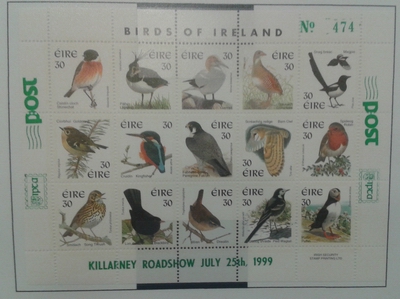
Stewart Templeton - 29th March 2012
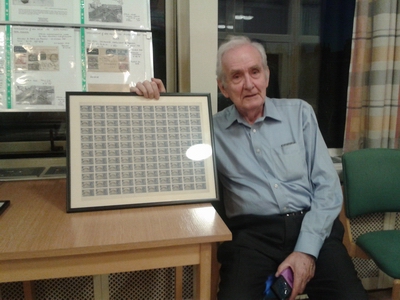
Francis Kiddle -15th March 2012
Filabusi is Mashona for "Dead Goat"!
Albert Megginson - Finland - 1st March 2012
Joe Ritchie - India - 2nd February 2012
Jammu & Kashmir - some early issues
Chad Neighbor - D-Day - 1st December 2011
Ron Goodfellow - Commerce in the Post - 17th November 2011
Chrissie Jefferies - Entertainment - 3rd November 2011
